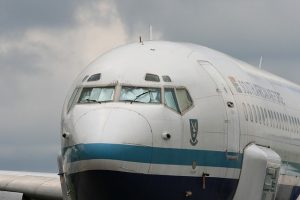 The fuselage is an important part of an airplane. All airplanes have a fuselage. It’s essentially the body or shell that holds passengers and cargo. In some airplanes, the fuselage holds the engines as well. While all fuselages feature a shell-like design, they are available in several different types. Below is a breakdown of the four most common types of airplane fuselages.
The fuselage is an important part of an airplane. All airplanes have a fuselage. It’s essentially the body or shell that holds passengers and cargo. In some airplanes, the fuselage holds the engines as well. While all fuselages feature a shell-like design, they are available in several different types. Below is a breakdown of the four most common types of airplane fuselages.
#1) Truss
Also known as truss structure, truss is a common type of airplane fuselage. It’s typically used in small and lightweight airplanes. Truss fuselages live up to their namesake by featuring steel trusses. The steel trusses are welded together to form a frame. This frame is then covered in sheets of steel or other materials. Truss fuselages have been around for over a century, and during that time, little has changed regarding their design.
#2) Monocoque
Some airplanes have a monocoque fuselage. Monocoque fuselages are characterized by the use of an exterior surface as the primary structure. In other words, they don’t have the same frame-based design as truss fuselages. Monocoque fuselages may still have a frame, but their primary structure consists of an exterior surface. Monocoque fuselages are found in military airplanes as well as commercial and civilian airplanes. The Boeing 787, in fact, uses a monocoque fuselage.
#3) Semi-Monocoque
In addition to monocoque, there are semi-monocoque airplane fuselages. Semi-monocoque is the most common type of fuselage for aluminum airplanes. Airplanes that are designed mostly of aluminum typically have a semi-monocoque fuselage. What is a semi-monocoque fuselage exactly, and how does it differ from a monocoque fuselage?
Semi-monocoque is a type of airplane fuselage that features a cross-section frame that’s joined together with stringers. Stringers are sheets of aluminum. The sheets of aluminum are attached to the cross-section frame with rivets and/or adhesives. Once in place, the combination of the aluminum sheets and cross-section frame form the fuselage. Semi-monocoque fuselages have an exterior surface — just like monocoque fuselages — but they also feature aluminum sheets.
#4) Geodesic
Finally, geodesic airplane fuselages are those that feature a basket-like woven construction. They consist of metal or synthetic materials that are angled together. The geodesic fuselage was pioneered by Barnes Wallis in the 1930s. Some of the first airplanes to use this fuselage appeared shortly thereafter. Geodesic is simply a type of airplane fuselage that features a basket-like construction. It’s considered stronger and more durable than many other types of fuselages.



